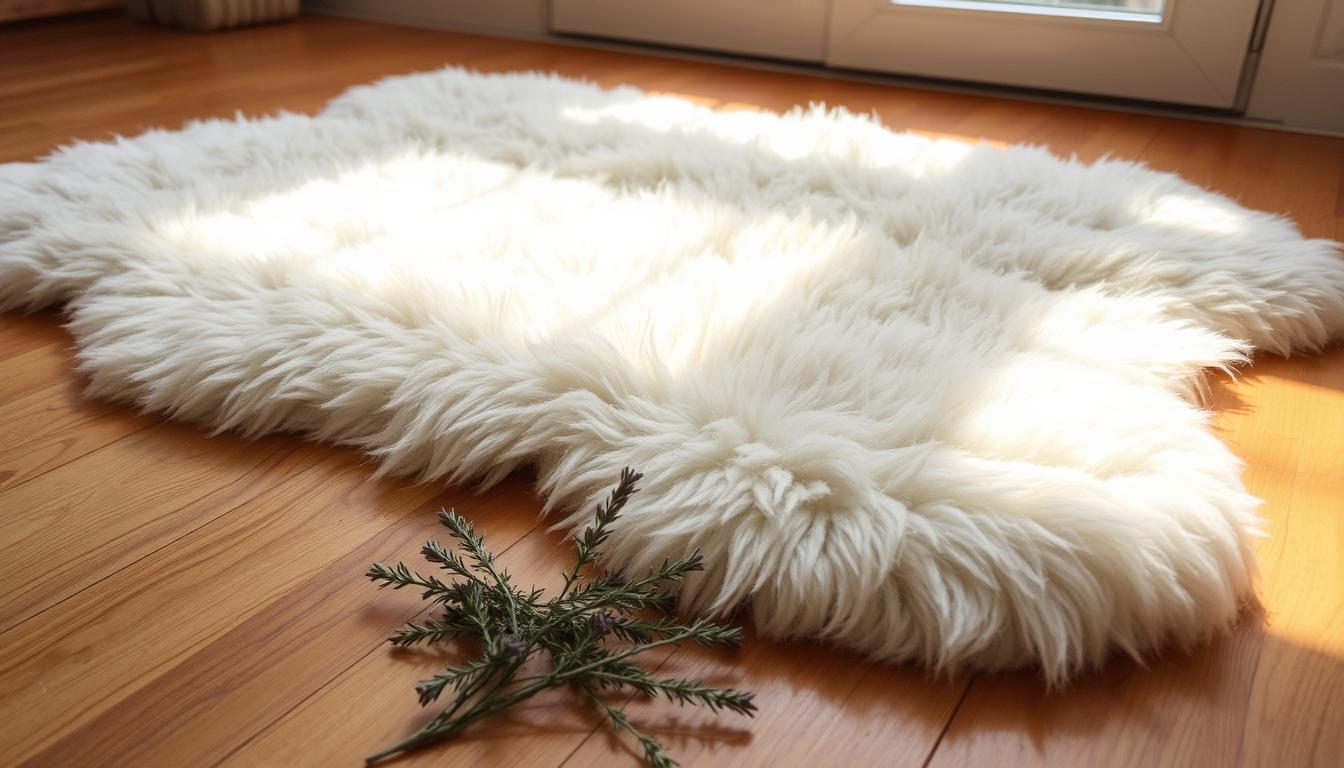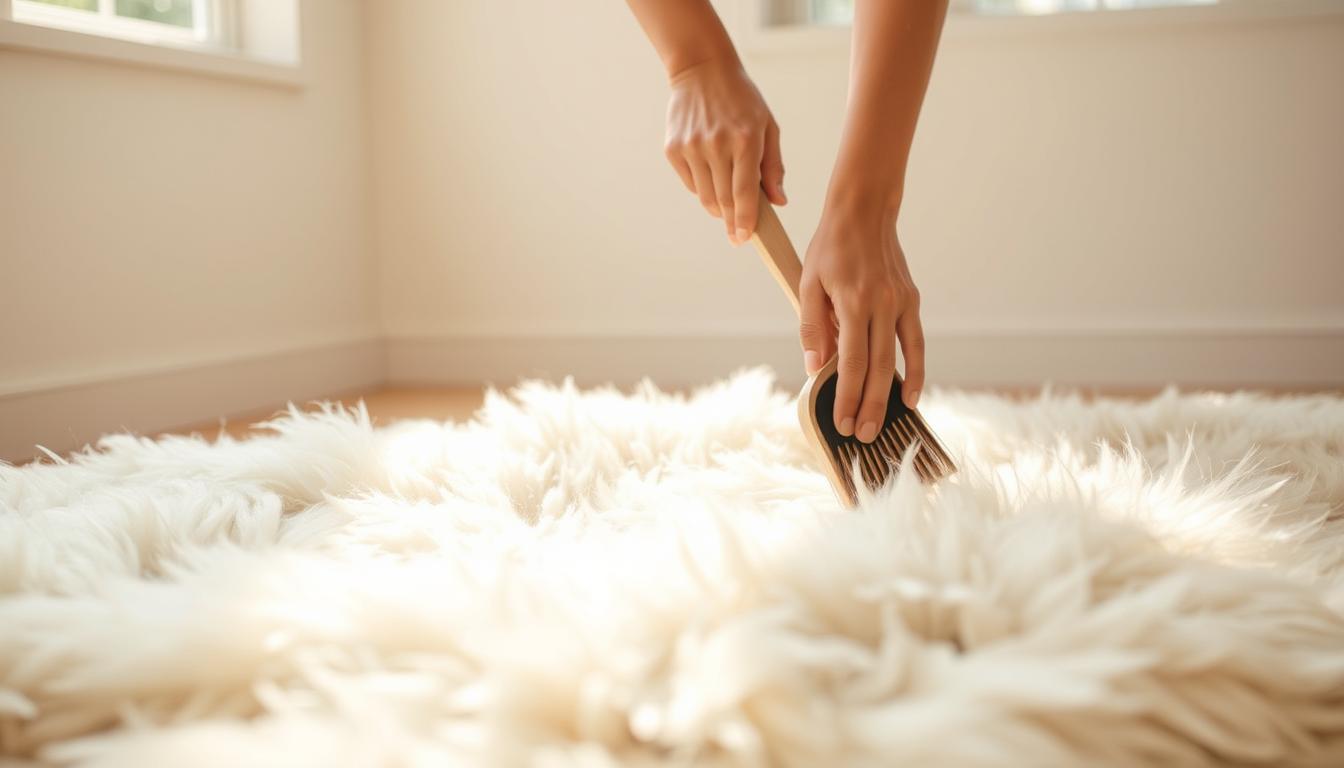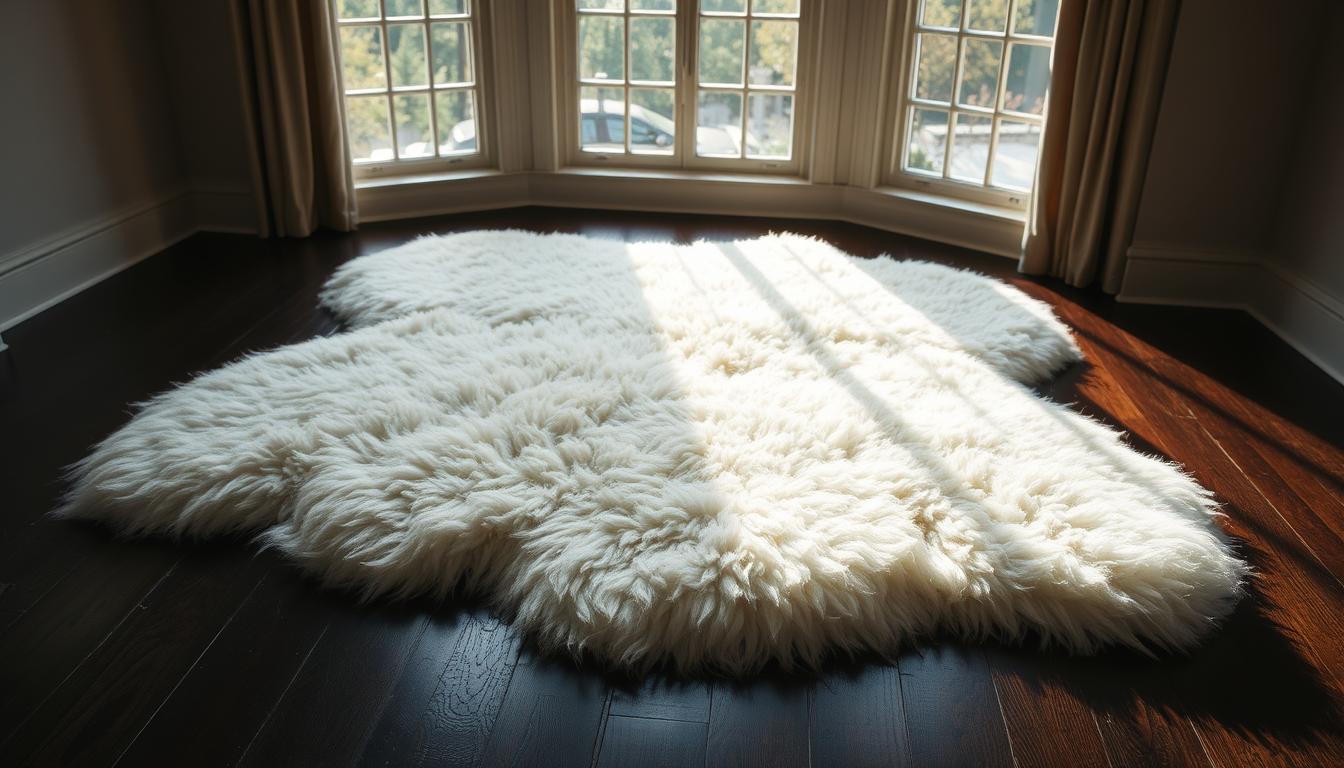
Sheepskin Rug Smell: 4 Gentle Ways to Deodorize Naturally
Sheepskin rug smell usually fades with airing and gentle cleaning.
That luxurious, natural fiber accent in your living room might bring warmth to your space—but what if it’s also trapping stubborn smells?
Organic materials like wool and leather have unique properties that require specific care, especially when freshness fades. The good news? You don’t need harsh chemicals to restore your favorite decor piece to its original glory.

High-quality natural fibers contain protective waxes like lanolin, which help maintain their durability. However, these same organic compounds can create earthy scents when new or absorb household odors over time.
Understanding this balance is key to choosing safe, effective solutions that preserve your investment.
In this guide, you’ll uncover four gentle techniques to neutralize odors while protecting delicate fibers. Learn to distinguish between normal natural aromas and problematic smells needing attention.
We’ll focus on immediate fixes for recent purchases and strategies to keep your decor fresh for years—all using ingredients you likely already have at home.
Key Takeaways
- Natural wool wax (lanolin) contributes to initial earthy scents in quality fiber decor
- Odor absorption increases when natural materials stay in enclosed spaces
- Gentle airing techniques can resolve 80% of new decor scent concerns
- Baking soda proves more effective than commercial sprays for deep cleaning
- Sunlight exposure timing is crucial to prevent fiber damage during deodorizing
- Regular maintenance prevents odor buildup better than reactive treatments
Understanding Sheepskin Rug Smell
Your plush floor accent carries distinct aromas shaped by its creation journey.
Three primary factors influence these scents: 1. production methods, 2. material composition, and 3. environmental exposure.
Common Causes of Odors
Fresh natural fiber decor often carries earthy notes from protective wool wax. This substance helps repel moisture but creates temporary musky undertones. Leather processing techniques also contribute—vegetable-tanned pieces might smell woody, while chrome-treated versions could have sharper chemical notes.
Storage conditions dramatically affect scent profiles. Pieces kept in basements or attics frequently develop musty characteristics. Unlike production-related aromas, these damp-associated odors signal potential mold growth needing immediate attention.
Natural vs. Unwanted Scents
Beneficial lanolin-based scents typically fade within 14 days when airing properly. You'll recognize them as mild, organic smells resembling warm hay. Persistent fishy or sour notes suggest bacterial activity, while sharp chemical odors indicate incomplete tanning processes.
Use this quick reference to identify scent types:
- Normal: Earthy lanolin (1-2 weeks), mild leather essence
- Concerning: Ammonia-like sharpness, mildew undertones
For lasting freshness, combine regular air circulation with proper maintenance techniques. This approach preserves natural protective oils while preventing odor absorption in high-traffic areas.
How to Make Sheepskin Smell Nice: Regular Care and Maintenance Tips
Preserving the beauty of natural fiber decor starts with simple habits that prevent dirt buildup. Unlike synthetic materials, wool’s structure traps particles that can degrade quality over time. A proactive approach keeps your investment looking lush while minimizing deep-cleaning needs.
Shaking and Brushing for Longevity
Weekly shaking works wonders for lifting debris before it settles into fibers. Take your decor piece outdoors and snap it sharply—like cracking a whip—to dislodge dust and crumbs. High-traffic areas demand this treatment every 2-3 days to maintain freshness.
Long-haired varieties benefit from gentle brushing with wide-tooth combs. Always stroke in the direction of hair growth to avoid breakage. This separates matted strands and restores airflow between fibers, crucial for preventing stale odors.
Curly textures require different handling. Their coiled structure naturally resists dirt but loses definition when brushed. Instead, use your fingers to fluff the curls gently after shaking. This preserves their springy character while dislodging surface particles.
Daily maintenance takes less than a minute but extends your decor’s lifespan exponentially. Pair these habits with monthly deep-airing sessions near an open window. Your efforts will keep the fibers resilient and naturally fresh for years of cozy enjoyment.
Spot Cleaning and Stain Removal Techniques
Accidents happen—but quick thinking keeps your decor looking pristine. Natural fiber accents demand specific stain treatment to avoid permanent damage. Follow these proven methods to tackle spills without harming delicate materials.
Immediate Action Steps for Spills
Blot first, panic later. Grab dry paper towels and press firmly on liquid spills. Never rub—this pushes substances deeper into fibers. For sticky messes like syrup, let residues dry completely before brushing gently with a soft-bristle tool.
Flip the piece fur-side down immediately after spills. This protects the leather backing and lets gravity work in your favor. Solid debris? Scoop it carefully with a spoon’s edge to prevent spreading.
Effective Tools and Methods
Mix warm water with wool-specific shampoo for most liquid stains. Test solutions on hidden areas first—some natural dyes may react unexpectedly. For red wine or blood, add equal parts white vinegar to boost cleaning power.
Use microfiber cloths for controlled application. Work from the stain’s edge toward the center to contain spills. After treatment, pat the area dry and air-fluff fibers using a cool hairdryer on low settings.
Regular maintenance through proper cleaning guide practices prevents small mishaps from becoming odor nightmares. Store your stain removal kit nearby for instant access when life gets messy.
Deodorizing Naturally Without Harsh Chemicals
Reviving your decor's freshness doesn't require industrial-strength products. Gentle methods work best for maintaining natural materials while eliminating unwanted scents. Let's explore safe approaches that protect fibers and enhance your space's ambiance.
Air Ventilation and Avoiding Direct Sunlight
Hang your decor overnight in covered outdoor spaces like porches or carports. This allows airflow without moisture risks. Rotate the piece twice during airing to expose all surfaces—especially effective after rainy seasons when humidity lingers.
Never leave materials under direct sunlight longer than 30 minutes. UV rays break down protective oils, causing brittleness. For indoor refreshment, position near open windows with fans creating cross-breezes. This circulates air through dense fibers naturally.
Using Baking Soda and Essential Oils
Sprinkle a thin layer of baking soda across the surface after shaking loose debris. Let it sit 4-6 hours—overnight for strong odors. The powder absorbs trapped particles without abrasive scrubbing. Vacuum thoroughly using upholstery attachments to preserve texture.
Enhance freshness with diluted essential oils. Mix 5 drops of lemon or peppermint oil with 1 tablespoon water. Dab lightly on leather undersides using cotton swabs. This prevents oil saturation in wool while distributing subtle fragrance.
Avoid commercial sprays containing alcohols or silicones. These strip natural waxes that maintain fiber elasticity. For persistent issues, repeat airing and baking soda treatments weekly until scents dissipate completely.
Washing Sheepskin Rugs in the Washing Machine: Pros and Cons
Machine cleaning offers a quick fix for deep-set odors, but requires careful evaluation. While some natural fiber decor can handle this method, improper use causes permanent damage. Let’s examine when this approach works—and when it risks ruining your cherished piece.
Assessing Suitability and Safety Tips
First, identify your item’s tanning method. Salt-tanned pieces dissolve in water, while medically treated versions withstand machine cycles. Check manufacturer tags or test a hidden corner with damp cloth—salt treatments leave crystalline residues when dry.
| Tanning Type | Water Safe? | Result After Washing |
|---|---|---|
| Salt | No | Leather disintegration |
| Medical | Yes | Hardened backing |
| Vegetable | Limited | Color bleeding |
If machine washing becomes necessary, use cold water and wool-specific detergent. Never exceed 30-minute cycles—extended agitation mats fibers irreversibly. Place the item in mesh laundry bags to reduce friction during spins.
Proper Drying and Post-Wash Care
Remove excess water by rolling the piece in clean towels. Lay flat outdoors away from direct sunlight, flipping every 2 hours. Use wide-tooth combs on damp fibers to prevent tangling—work slowly from tips to roots.
Expect texture changes regardless of precautions. The leather backing stiffens by 40-60%, altering how the piece drapes. For partial softness restoration, massage glycerin-based conditioners into dried leather undersides.
Remember: machine cleaning should address only severe contamination. For routine care, stick to airing and spot treatments. Your decor maintains its luxurious feel longer through gentle maintenance rather than aggressive washing.
Advanced Cleaning Methods for Deep Odor Removal
When surface treatments fall short, specialized techniques restore freshness to cherished decor. These intensive processes require careful execution but eliminate odors commercial products can’t touch. Let’s compare two professional-grade approaches for reviving heavily used pieces.
Hand Washing Versus Steam Cleaning
Immersion cleaning works best for persistent odors needing full fiber treatment. Fill a bathtub with cold water and wool-safe detergent. Submerge the item completely, gently swishing without twisting. This motion lifts trapped particles while preserving natural texture.
Steam methods suit delicate vintage pieces that can’t handle water immersion. Hold the nozzle 6 inches above fibers, moving with their growth pattern. Limit sessions to 15 minutes to protect leather integrity. Both methods demand meticulous drying—lay pieces flat with backing facing upward for air circulation.
| Method | Best For | Time Investment | Leather Safety |
|---|---|---|---|
| Hand Wash | Severe contamination | 3-5 days drying | High (cold water) |
| Steam Clean | Antique items | 1-2 days drying | Moderate (low heat) |
Post-treatment care determines long-term results. Never accelerate drying with heaters or sunlight—natural evaporation prevents fiber damage. For wet cleaning methods, rotate the piece every 8 hours to ensure even moisture release. Patience rewards you with refreshed materials that maintain their original softness.
Choose immersion for comprehensive renewal or steam for targeted refreshment. Both processes out perform surface treatments when odors penetrate deep into natural fibers. Proper execution preserves your decor’s luxurious feel while banishing stubborn scents permanently.
How to Get Smell Out of Sheepskin Rug: Preventative Measures to Maintain Freshness
Keeping your natural fiber decor fresh starts with simple habits that stop odors before they begin. Proper care preserves both appearance and texture while reducing deep-cleaning needs. Focus on techniques that work with wool’s natural properties rather than against them.
Routine Vacuuming and Gentle Brushing
Weekly vacuuming lifts dirt particles before they settle into fibers. Use upholstery attachments without beater bars to avoid tangling strands. For high-traffic areas, increase frequency to twice weekly during dusty seasons.
Wire brushes with rounded tips maintain texture without snagging. Glide through strands in their natural growth direction—this preserves curl patterns while removing debris. Proper brushing prevents matting that traps moisture and odors over time.
Rotate your decor every 3-4 weeks to distribute wear evenly. This simple step prevents permanent indentations where dirt accumulates. Pair rotation with monthly airing sessions near open windows for maximum freshness.
Follow these proper maintenance steps to protect natural oils and extend your decor’s lifespan. Consistent care saves time and money compared to reactive cleaning methods. With minimal effort, your investment stays plush and inviting for years.
Conclusion
Maintaining your natural fiber decor’s freshness comes down to smart habits and simple solutions. Regular airing sessions and targeted baking soda treatments tackle most odor challenges without harsh products. Consistency matters more than intensity—gentle weekly care beats aggressive yearly cleanings.
Always choose wool-safe methods when addressing spills or smells. Harsh chemicals strip protective oils, while natural approaches preserve texture and durability. For stubborn issues, follow proper sheepskin rug cleaning steps to avoid damaging delicate fibers.
Make sure to rotate and brush your decor regularly to prevent matting. A few minutes each day keeps materials resilient against dirt buildup. With the right techniques, you’ll enjoy cozy comfort without compromising quality—because true luxury should feel effortless.
FAQ
Can you wash sheepskin rugs in a washing machine?
Some modern machines have gentle cycles suitable for natural fibers. Always check the care label first. Use cold water, mild detergent, and avoid spin cycles. Air-dry flat away from direct sunlight to prevent leather hardening.
How do you remove stubborn stains without damaging the wool?
Blot spills immediately with a clean cloth. Mix a small amount of wool-safe shampoo with water, dab the area, and rinse lightly. Avoid rubbing, as friction can weaken fibers. Pat dry and brush gently once fully dry.
What natural methods eliminate odors effectively?
Sprinkle baking soda lightly over the surface, let it sit for 15–20 minutes, then brush it off. For freshness, add 2–3 drops of essential oils like lavender to the baking soda. Ensure proper air circulation to speed up the process.
Does sunlight help reduce lingering smells?
Indirect airflow is better. Direct UV rays can dry out the leather backing and fade colors. Hang the rug outdoors in a shaded, breezy area for 1–2 hours instead. Rotate periodically for even deodorizing.
How often should you clean these rugs to prevent odors?
Shake them weekly to remove dust. Vacuum with a low-suction attachment every 2–3 weeks. Spot-clean spills immediately. Deep-clean every 6–12 months, depending on use, to maintain softness and freshness.
Can steam cleaning damage the leather backing?
High heat or moisture exposure may cause shrinkage or cracking. Hand-washing with lukewarm water and specialized cleaners is safer. Always test a hidden area first and prioritize gentle techniques for long-term care.











